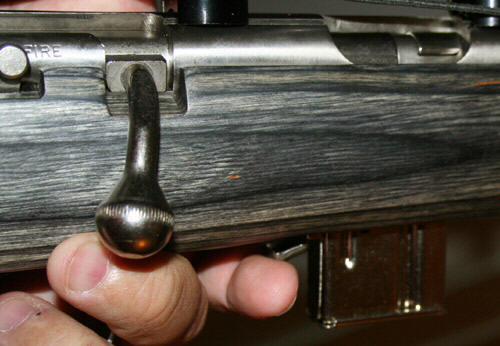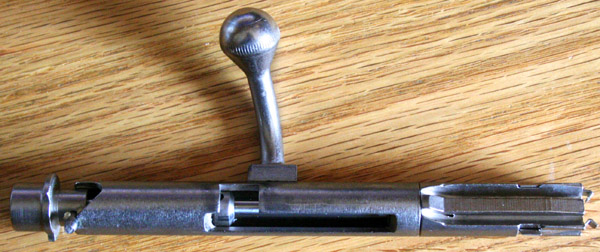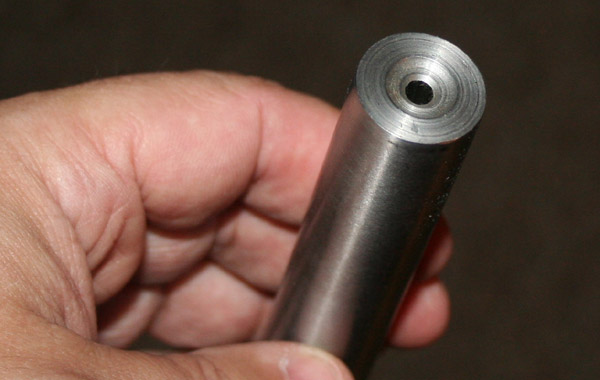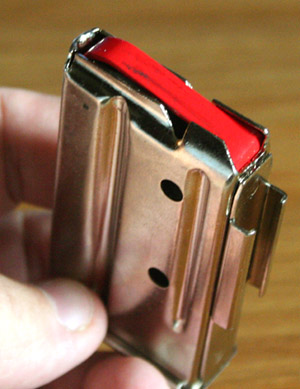|

Marlin 17
| Length Overall |
Barrel Length |
Weight |
Caliber |
Action Type |
Magazine Capacity |
| 41 Inches |
22 Inches |
7 Pounds |
17 HMRF |
Bolt |
7 |
This is only my second firearm in 17 caliber, my first being a
revolver, and is also only my second bolt action repeater. I picked
up this gun as a companion piece for my little Taurus revolver, and
also because the 17 HMRF is that flattest shooting rimfire cartridge
you can buy, as well as being one of the flattest shooting
recreational cartridges of any kind. This was originally designed as
a varmint round, for use against prairie dogs, coyotes, rats, and
other fast moving pesky little critters. I don't hunt; but even a
non-hunter like myself can appreciate the speed and flat trajectory
of this incredible little round. Varmint Al, and others, love this
round, and if you want to learn more about it, one of the best places to start
is at
http://www.varmintal.com/17hmr.htm
 This rifle is based upon the action of the Marlin 22 Magnum bolt, and Marlin's
experience at rifle making shows to good advantage here. Though Marlin is not
out largest gun maker (presently, this distinction belongs to Ruger), it is the
largest producer of rimfire rifles, and the company acquits itself well in the
execution of this particular model, with the exception of the magazine, which is
dealt with in the paragraphs below. The rifle looks good. The stock is nicely
laminated, and will not warp or swell in extremes of weather. In similar
fashion, the stainless barrel, receiver and bolt are not likely to become
victims of the weather either. As far as appearance goes, the best features of
this rifle are that gleaming heavy barrel, and the nicely dimensioned laminated
stock. The clean lines are broken up, a bit, by the 7 round magazine hanging out
of the bottom. For those who object, a four round, flush fitting mag is
available. I would rather have the extra three rounds. At first glance, the
tubular receiver appears to have been stamped and rolled; but upon close
examination, it is obvious that it has been machined from bar stock, well
finished, and thick walled for sturdiness -- very nice. The bolt appears to have
been similarly made, though in two pieces. The stock, and receiver are well
fitted, with no sloppiness, and no sign of a rattle or movement.
This rifle is based upon the action of the Marlin 22 Magnum bolt, and Marlin's
experience at rifle making shows to good advantage here. Though Marlin is not
out largest gun maker (presently, this distinction belongs to Ruger), it is the
largest producer of rimfire rifles, and the company acquits itself well in the
execution of this particular model, with the exception of the magazine, which is
dealt with in the paragraphs below. The rifle looks good. The stock is nicely
laminated, and will not warp or swell in extremes of weather. In similar
fashion, the stainless barrel, receiver and bolt are not likely to become
victims of the weather either. As far as appearance goes, the best features of
this rifle are that gleaming heavy barrel, and the nicely dimensioned laminated
stock. The clean lines are broken up, a bit, by the 7 round magazine hanging out
of the bottom. For those who object, a four round, flush fitting mag is
available. I would rather have the extra three rounds. At first glance, the
tubular receiver appears to have been stamped and rolled; but upon close
examination, it is obvious that it has been machined from bar stock, well
finished, and thick walled for sturdiness -- very nice. The bolt appears to have
been similarly made, though in two pieces. The stock, and receiver are well
fitted, with no sloppiness, and no sign of a rattle or movement.
The rather traditionally designed, stainless bolt
features dual extractors, and a rebounding firing pin, which is sent on it's way
by a very long hammer, which has more the appearance of a striker. The bolt is
locked, by a single lug, placed right where the bolt handle emerges. Though not up to the strength of the dual or
triple lugs found in high powered hunting rifles, the single lug is more than
enough to handle the power of the little 17 rimfire. Quality is reasonably good,
and the piece seems quite well finished. There is a red cocking indicator, as
well as a cocking piece, like that of an old Springfield rifle, so that status
may be seen or felt. The bolt is easily removed, by the standard method of
holding the trigger down, while cocking and then pulling the bolt to the rear.
This bolt is not as smooth as it could be, evincing a bit of a lag as the handle
unlocks. Even so, this can be gotten used to with practice, is
not terribly
cumbersome. The Marlin bolt has the older style round head on the handle.
where the bolt handle emerges. Though not up to the strength of the dual or
triple lugs found in high powered hunting rifles, the single lug is more than
enough to handle the power of the little 17 rimfire. Quality is reasonably good,
and the piece seems quite well finished. There is a red cocking indicator, as
well as a cocking piece, like that of an old Springfield rifle, so that status
may be seen or felt. The bolt is easily removed, by the standard method of
holding the trigger down, while cocking and then pulling the bolt to the rear.
This bolt is not as smooth as it could be, evincing a bit of a lag as the handle
unlocks. Even so, this can be gotten used to with practice, is
not terribly
cumbersome. The Marlin bolt has the older style round head on the handle.
The gun is easy to shoot, and is
marvelously accurate. It is a real ego booster out on the range, not merely
because of it's fine accuracy, but also because of the ease with which this
accuracy can be realized. I can consistently shoot sub one inch groups at 100
yards, some as low as half an inch. Only my Ultra Match, and Texas magnum rifles
can shoot as well. I credit much of
 this to the
heavy bull barrel. This is similar to aftermarket barrels being sold for the
Ruger 10/22, and really does help with accuracy. It is .83 inches thick, and a
fluted version is available. This thick barrel is capped with a recessed, and
fully crowned muzzle. A standard barrel is also offered; hut for me, it was no
contest. The heavy barrel offers so many advantages, that the slight difference
in weight seems a more than fair trade off. The recoil of this little rifle is
negligible, and the flat trajectory gives a nice point blank range, far better
than that of any other rimfire cartridge. this to the
heavy bull barrel. This is similar to aftermarket barrels being sold for the
Ruger 10/22, and really does help with accuracy. It is .83 inches thick, and a
fluted version is available. This thick barrel is capped with a recessed, and
fully crowned muzzle. A standard barrel is also offered; hut for me, it was no
contest. The heavy barrel offers so many advantages, that the slight difference
in weight seems a more than fair trade off. The recoil of this little rifle is
negligible, and the flat trajectory gives a nice point blank range, far better
than that of any other rimfire cartridge.
There are no iron sights on this gun. The
receiver is drilled and tapped for a scope, and mounts are included (though not
rings). It is also grooved for rings to attach directly. It was properly assumed
that there would be little need for iron sights on a rifle of this type. This
particular rifle was immediately topped with a 3 -9 x 32 scope. Not the best
scope; but it will do for now. On the other hand, this was the scope though
which I shot half in groups; so how bad can it be? Still, in the future I am
planning on something in the 4 - 16 by 40mm or perhaps 44mm range.
The new trigger system of the Marlin is
justifiably being highly promoted by the company. Though a bit heavy (over five
pounds), the trigger breaks cleanly, with almost no creep at all. The system is
also quite simple, and should give good service. My only problem with it, is the
plastic construction of the wide, grooved, trigger. The trigger guard, despite
it's color and appearance, also seems to be made of plastic. In these days of
plastic pistols, like the Glock and the S&W Sigma series, the use of this material is far more acceptable than had once been the
case. Still, it remains to be seen how durable this construction will prove to
be . If nothing else, plastic does not rust.
series, the use of this material is far more acceptable than had once been the
case. Still, it remains to be seen how durable this construction will prove to
be . If nothing else, plastic does not rust.
The gun is not perfect, and has one particularly
annoying quirk. Sadly, the dual extractors of the bolt, and generally good
quality of construction can not save this rifle from it's magazine. The magazine
can be difficult to seat properly, and even when properly seated will sometimes
not feed properly. Marlin has, unfortunately, simply taken the design of a
standard 22 rifle magazine, and transposed it onto their new rifle. What has
worked quite well on generations of 22 rifles, does not work satisfactorily with
the new 17 HMR. A magazine well block would
 probably fix
this problem, or perhaps a magazine with a more sturdy rail. At any rate, if
these rifles become really popular, which seems likely, the aftermarket will
certainly address the problem. Marlin uses the same magazine design, for it's 22
Magnum, and 17 HRFM rifles, so a redesigned magazine follower might be another
way to solve this problem. probably fix
this problem, or perhaps a magazine with a more sturdy rail. At any rate, if
these rifles become really popular, which seems likely, the aftermarket will
certainly address the problem. Marlin uses the same magazine design, for it's 22
Magnum, and 17 HRFM rifles, so a redesigned magazine follower might be another
way to solve this problem.
Not wanting to end this page on a sour note, I must
repeat that I really like this gun, and have been having quite a bit of fun with
it. The magazine issue notwithstanding, this is a great little rimfire rifle,
and is widely regarded as one of the most accurate rifles in this caliber. How
many other production rifles are capable of shooting half inch groups? Paired
with one of the increasing number of 17 magnum pistols hitting the market, this
would be a great senior partner in a rimfire rifle - handgun combo. Though not
exactly a plinking combo, due to the relatively high cost of 17 ammunition, this
pair has great potential for varmint shooting, as well as being a great deal of
fun.
Regarding the cost of the cartridges (about $10 -
$12 per 50, as of this writing), this is about the same as a good box of 38
Special, or perhaps a standard 9mm load. So in contrast to your basic 22
rimfire, which costs about $1 for a box of 50 rounds, the 17 is about in a par
with a centerfire carbine, or maybe even a military style semi auto, if surplus
ammunition is used. Still, a day out in the woods, with this rifle in my hands,
and my Taurus 17 caliber revolver on my hip, is a fun day. And hey, if you can't
spend a little money to have a good time, then what is it good for? The rifle
itself sells for about $225 - $250, with the blue version costing about $50
less. The fancier, but less accurate, Ruger 77/17, which I had also been
considering buying, sells for about $400, and has a much better magazine. You
make your choices, and you pay your money. |

